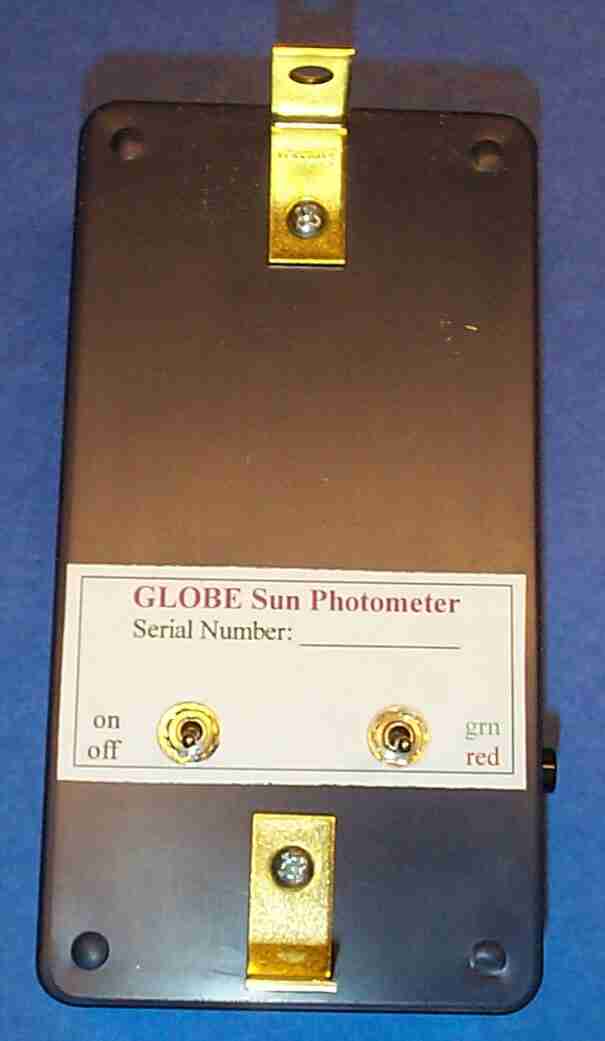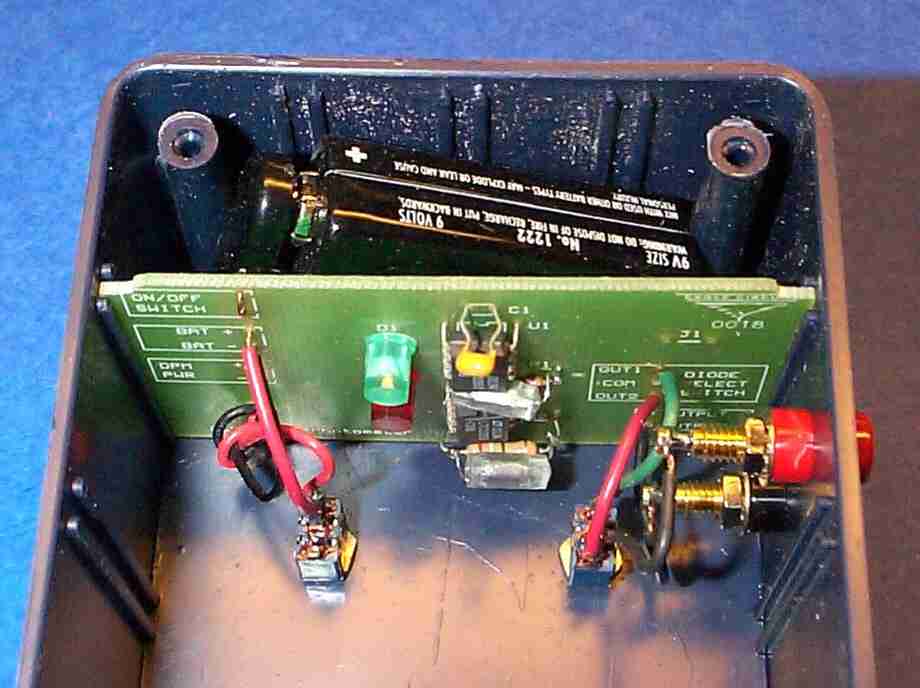Introduction to Sun Photometers
Introduction to Sun Photometers
The GLOBE Aerosol Monitoring Project uses sun photometers to measure the concentration
of aerosols in the atmosphere. What is a sun photometer, and how does it work?
What does a sun photometer look like?
A sun photometer is an electronic device that measures direct sunlight over a narrow range of wavelengths. That
is, it measures light of a particular color. The detector used to measure sunlight determines these wavelengths. Some
sun photometers use "interference filters" to limit the amount of light reaching a photosensitive detector. These
filters, which limit the range of sunlight to as little as 1 or 2 nanometers,
are expensive and very fragile.
So, they aren't suited for use by students.
For the GLOBE program, the Science Team (David Brooks and Forrest Mims) has developed
sun photometers that use light emitting diodes (LEDs) as detectors. It may be surprising to hear that these ubiquitous
light emitting devices can also operate as detectors, but they actually work quite well in this application. The only disadvantage
is that LEDs respond to a broader range of wavelengths than detectors that include interference filters. We have discussed
LED-based sun photometers in a peer-reviewed scientific journal (the Journal of Geophysical Research), which means that this
concept has been reviewed and accepted by the scientific community.
 The picture to the right shows an outside view of the GLOBE sun photometer. It is housed in a plastic
case about 15x8x5 cm (6"x3"x2"). On the top of the case, there are two alignment brackets. In use, the instrument
is pointed at the sun so that light passes through the hole in the front bracket and makes a bright spot that
shines on a piece of paper
covering the rear bracket. Out of sight at the "top" end of the instrument as shown here, there is a small round
hole, 5.5 mm (7/32") in diameter. When the instrument is pointed at the sun, sunlight shines through this hole.
Depending on where the light spot is aligned on the rear bracket, sunlight will strike one of two detectors inside the
case.
The picture to the right shows an outside view of the GLOBE sun photometer. It is housed in a plastic
case about 15x8x5 cm (6"x3"x2"). On the top of the case, there are two alignment brackets. In use, the instrument
is pointed at the sun so that light passes through the hole in the front bracket and makes a bright spot that
shines on a piece of paper
covering the rear bracket. Out of sight at the "top" end of the instrument as shown here, there is a small round
hole, 5.5 mm (7/32") in diameter. When the instrument is pointed at the sun, sunlight shines through this hole.
Depending on where the light spot is aligned on the rear bracket, sunlight will strike one of two detectors inside the
case.
 The two LED detectors in the GLOBE sun photometer respond to red or green light.
The second picture shows an inside view of the sun photometer case. The view is from the front of the case, looking
toward the rear, The LED detectors are located just to the left of the center of the green printed circuit board. The
battery is behind the printed circuit board.
The two LED detectors in the GLOBE sun photometer respond to red or green light.
The second picture shows an inside view of the sun photometer case. The view is from the front of the case, looking
toward the rear, The LED detectors are located just to the left of the center of the green printed circuit board. The
battery is behind the printed circuit board.
When sunlight strikes one of the LEDs, it produces a very small current (a flow of
electrons). This signal is amplified by the electronics, which are located to the right of the detectors. Amplifiers
that produce an output voltage proportional to an imput current are called transimpedance amplifiers. This device uses
a double operational amplifier (op amp); it is the black object just to the right of the LEDs.
How does a sun photometer measure the amount of aerosols in the atmosphere?
Remember that a sun photometer is supposed to measure only direct sunlight.
This is why the detectors are inside a case so that sunlight can enter only through a small hole. Otherwise, the
detectors would
see both direct sunlight and "sky light", which is essentially sunlight scattered by air
molecules in the atmosphere.
If you now think of a detector that sees only light coming directly from the sun,
then you can imagine sunlight passing through the atmosphere in a straight line to a detector on the ground. Depending
on how high the sun is above the horizon (its elevation angle), there is more or less atmosphere in between the observer
and the sun. Molecules in the atmosphere divert (scatter) some of the light coming from the sun. This effect, called
Rayleigh scattering, can be calculated for what is called a "standard atmosphere." The more atmosphere there is between
the sun and the detector, the smaller the current produced by the LED, and the smaller the output voltage
from the sun photometer's electronics.
The output voltage is also affected by the concentration of particles (aerosols) in
the atmosphere. These particles, which are suspended in the atmosphere, scatter or absorb sunlight. The higher the
concentration of aerosols, the smaller the amount of sunlight reaching the detector, and the smaller the sun photometer's
output voltage.
The changes in output voltage caused by aerosols can sometimes be very small. So, it
is important to calibrate sun photometers carefully. Basically, this involves inferring what the sun photometer
would see if there were no atmosphere between its detector and the sun. From the ground, this calibration is done by
looking at the sun through varying amounts of atmosphere and using a mathematical model to predict
what would happen to the output voltage if the
atmosphere suddenly disappeared. These calibrations are time-consuming, which explains both why "professional" sun photometers
are very expensive and why the GLOBE sun photometer is not available as a commercial product. Instead, the Aerosol
Monitoring Project's Science Team is responsible for producing and calibrating GLOBE sun photometers.
If you understand pre-calculus mathematics (logarithmic and exponential
functions), you can click here to find
a detailed explanation of how to calculate
aerosol optical thickness.
 The picture to the right shows an outside view of the GLOBE sun photometer. It is housed in a plastic
case about 15x8x5 cm (6"x3"x2"). On the top of the case, there are two alignment brackets. In use, the instrument
is pointed at the sun so that light passes through the hole in the front bracket and makes a bright spot that
shines on a piece of paper
covering the rear bracket. Out of sight at the "top" end of the instrument as shown here, there is a small round
hole, 5.5 mm (7/32") in diameter. When the instrument is pointed at the sun, sunlight shines through this hole.
Depending on where the light spot is aligned on the rear bracket, sunlight will strike one of two detectors inside the
case.
The picture to the right shows an outside view of the GLOBE sun photometer. It is housed in a plastic
case about 15x8x5 cm (6"x3"x2"). On the top of the case, there are two alignment brackets. In use, the instrument
is pointed at the sun so that light passes through the hole in the front bracket and makes a bright spot that
shines on a piece of paper
covering the rear bracket. Out of sight at the "top" end of the instrument as shown here, there is a small round
hole, 5.5 mm (7/32") in diameter. When the instrument is pointed at the sun, sunlight shines through this hole.
Depending on where the light spot is aligned on the rear bracket, sunlight will strike one of two detectors inside the
case.
 The two LED detectors in the GLOBE sun photometer respond to red or green light.
The second picture shows an inside view of the sun photometer case. The view is from the front of the case, looking
toward the rear, The LED detectors are located just to the left of the center of the green printed circuit board. The
battery is behind the printed circuit board.
The two LED detectors in the GLOBE sun photometer respond to red or green light.
The second picture shows an inside view of the sun photometer case. The view is from the front of the case, looking
toward the rear, The LED detectors are located just to the left of the center of the green printed circuit board. The
battery is behind the printed circuit board.